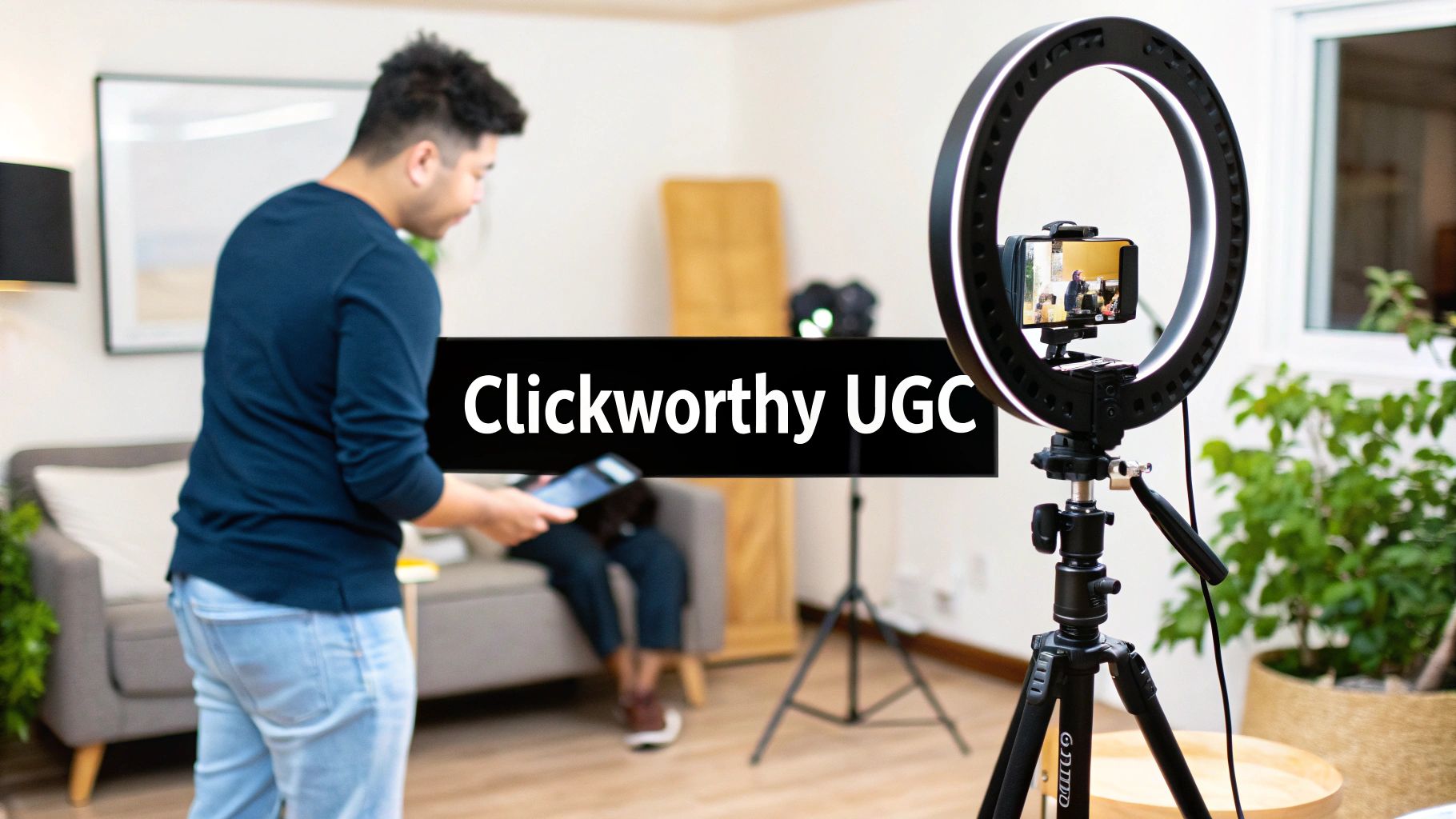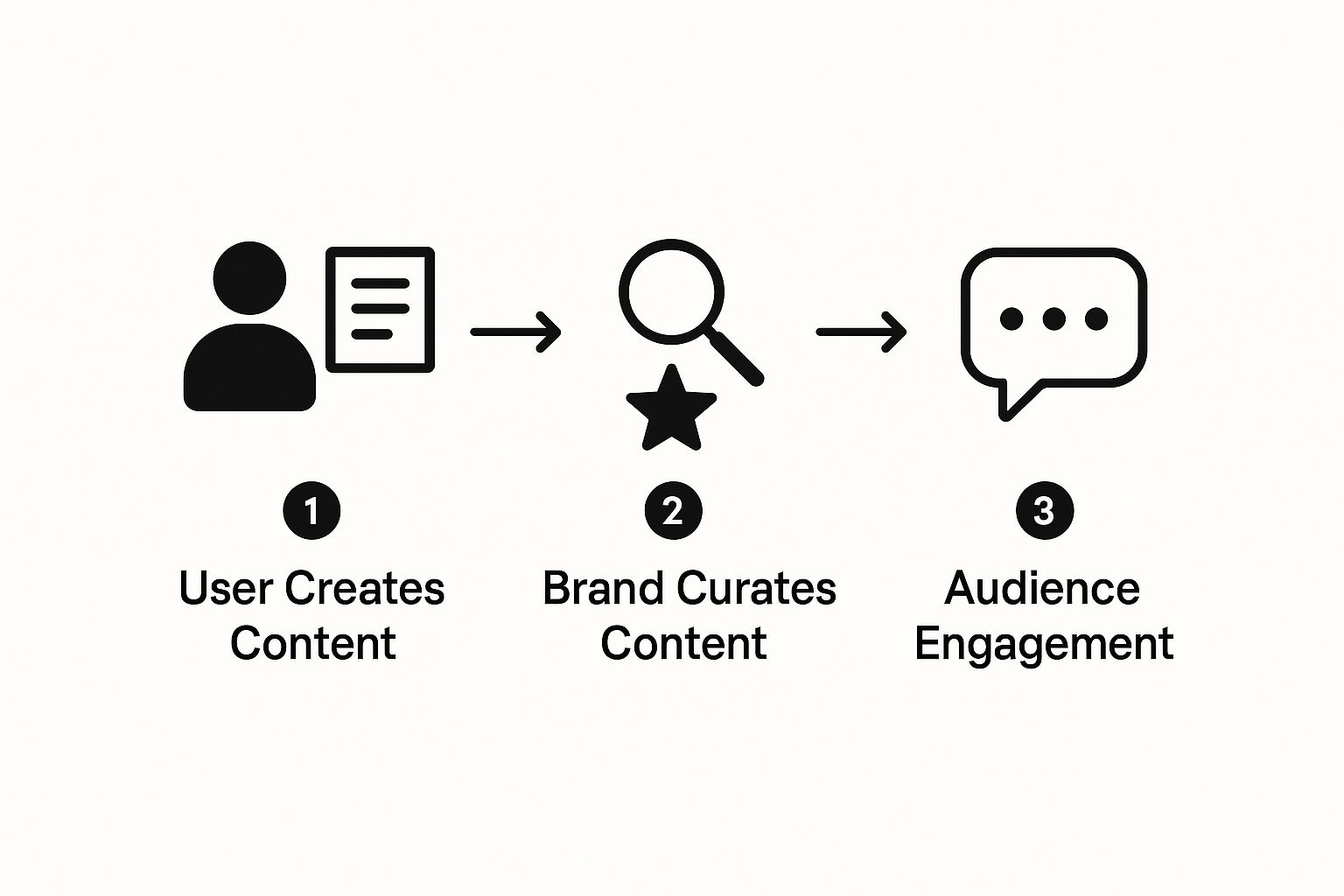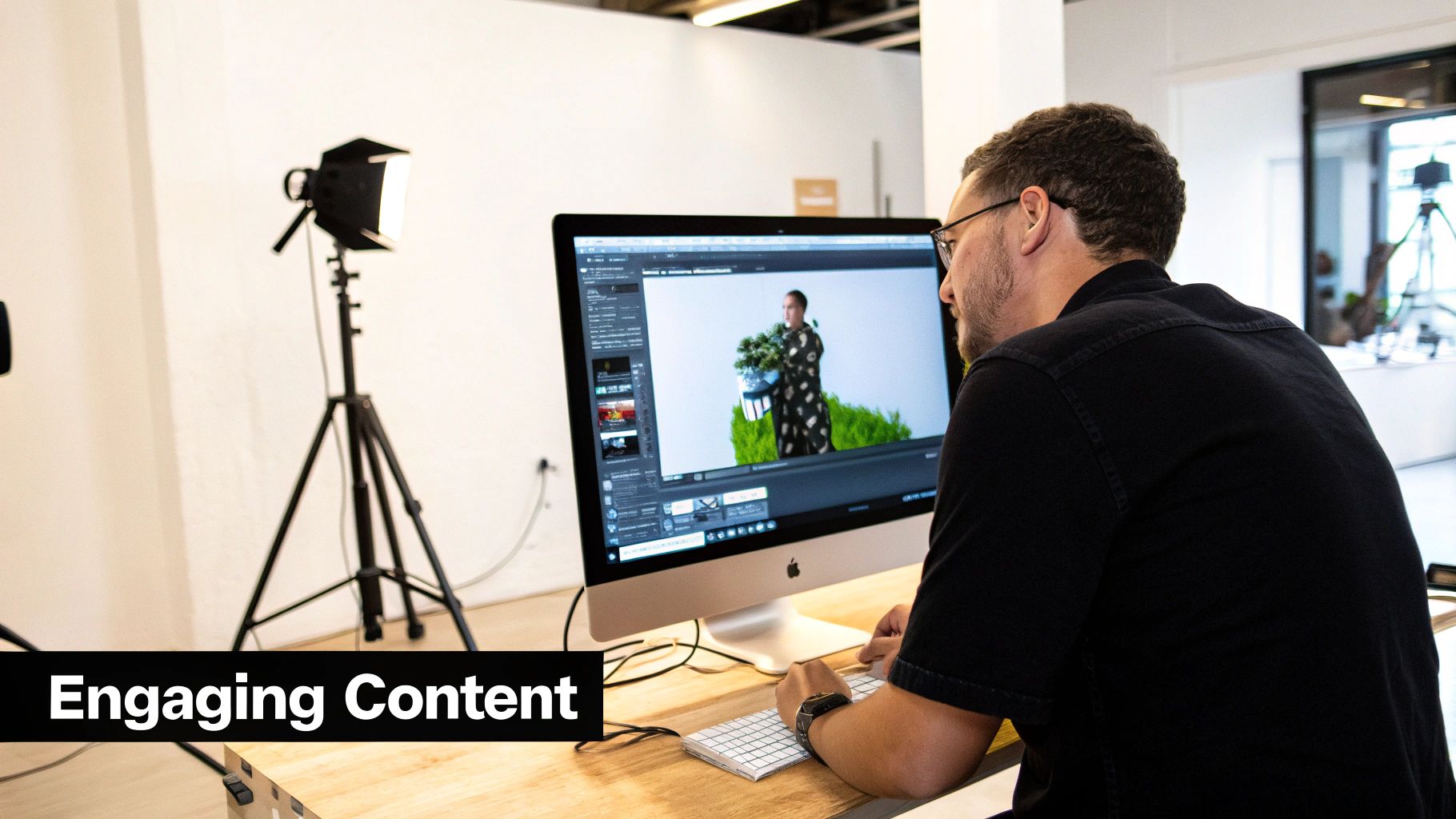
How to Make a UGC That Gets Clicks and Converts
Learn how to make a UGC that drives results. This guide covers everything from planning and scripting to filming and leveraging AI tools for authentic content.
Creating a powerful UGC video isn't about having a Hollywood budget. It really just comes down to a simple formula: plan an authentic angle, film with decent light and clear audio, and then edit it all down into a tight, compelling story.
The whole point is to create something that feels real and relatable, not like another slick ad.
Why Authentic UGC Just Hits Different
Before we get into the nitty-gritty of how to actually make a UGC video, it’s crucial to understand why this stuff works so well in the first place.
Let's be real—modern consumers are tired of being sold to. They're scrolling past polished, corporate advertising and looking for genuine connection and trust. That's exactly what UGC delivers. It’s the digital version of a friend giving you a solid recommendation.
This shift is completely changing how brands have to communicate. Authentic stories from real people build a kind of credibility that a massive ad spend simply can't buy. It's not just a "nice-to-have" anymore; it directly impacts buying decisions and helps build a loyal community.
The Power of Peer-to-Peer Trust
Think about your own buying habits. If you're on the fence about a product, what do you trust more? A brand’s perfectly crafted commercial, or a quick video from someone who actually bought and used it?
Most of us would go with the user's video every time. That's the magic of UGC. It cuts through the corporate polish and shows a genuine experience, warts and all.
UGC isn’t about perfection; it’s about connection. The slight imperfections are what make the content feel genuine and trustworthy to an audience that is increasingly skeptical of traditional advertising.
This simple cycle of a user creating something, and a brand sharing it, is what fuels incredible audience engagement. The process flow below shows just how that works.

As you can see, when a brand amplifies genuine user content, it creates this powerful feedback loop that strengthens community and builds trust. The key is to have a solid user-generated content strategy to harness this energy effectively.
This push for authenticity is also fueling some massive industry growth. The global UGC marketing space was valued at $6.7 billion in 2024 and is on track to hit a mind-blowing $132.73 billion by 2034. That's a staggering growth rate of 34.8% per year. These numbers from Market.us confirm it: knowing how to make UGC is no longer a fringe skill—it’s an essential part of modern marketing.
To get started, it helps to see the entire creation process from a bird's-eye view.
The UGC Creation Process at a Glance
Here is a quick overview of the key stages for making a UGC video, which we will explore in detail throughout this guide.
| Stage | Key Objective | Primary Focus | | :--- | :--- | :--- | | Planning | Define the angle and key message | Brainstorming concepts, scripting, and shot lists | | Filming | Capture high-quality, authentic footage | Lighting, audio clarity, and natural delivery | | Editing | Craft a compelling and concise narrative | Pacing, adding text overlays, and selecting music | | Optimizing | Prepare the video for platform-specific success | Resizing for different formats, writing captions |
Each of these stages plays a critical role in turning a simple idea into a piece of content that genuinely connects with an audience. Now, let's dive into the first step.
From Idea to Script: Mapping Out Your UGC

The best user-generated content feels like it was captured in the moment. Spontaneous. But that raw authenticity? It's almost always the product of a really solid plan.
Just winging it is a recipe for a rambling video that misses the mark. A little structure is what ensures your core message lands, all without losing that genuine vibe that makes UGC so powerful in the first place.
This whole process kicks off the second a brand brief lands in your inbox. Your first job is to tear it apart and pinpoint the non-negotiables: the main message, who they're trying to reach, and the exact call-to-action (CTA) they need. Don’t just skim it. You need to get the why behind their campaign.
Are they trying to show how a new face cream calms redness? Or maybe they want to highlight how a meal delivery service saves time for busy parents. Nailing down this core goal is your North Star. It guides every creative choice you make.
Finding Your Angle
Once you've got the objective locked in, you can start brainstorming angles that feel natural and, most importantly, relatable. This isn't the time to create a slick, mini-commercial. Think about it this way: how would you actually tell a friend about this product?
Here are a few classic angles that just plain work:
- First-Impression Unboxing: There's a reason this is a go-to. Capture your genuine, unfiltered reaction to the packaging and the product itself. It’s exciting, it’s raw, and it pulls the viewer right in.
- The Problem/Solution Demo: Show, don't just tell. If you're working with a stain remover, get a white t-shirt and spill some coffee on it. Show the product actually working. This delivers immediate, undeniable value.
- A "Day in the Life": Weave the product into your normal daily routine. This is perfect for lifestyle products because it shows how seamlessly it fits into real life, making it feel totally accessible.
- The Relatable Testimonial: This is all about your personal experience and the results. Speak from the heart about how the product genuinely helped you. That’s how you build trust and an emotional connection.
The trick is to pick an angle that not only hits the brand's goals but also feels completely true to your own voice.
A great UGC video doesn't just show off a product. It tells a tiny story where the customer is the hero and the product is their trusty sidekick. Your job is to frame that story in the most believable way you can.
How to Script Without Sounding Like a Robot
Let's be clear: scripting UGC isn't about writing down every single word. It’s about creating a simple framework to keep you on track. Over-scripting is the fastest way to sound fake and kill the authentic feel.
Instead, I always rely on a simple, three-part structure.
This little framework ensures your video is tight, impactful, and nudges the viewer toward that all-important CTA. Think of it as a loose roadmap, not a word-for-word script.
The Simple UGC Scripting Framework
| Part | Purpose | Example (for a fictional energy drink) | | :--- | :--- | :--- | | The Hook | Grab attention in the first 3 seconds. | "I've officially found the perfect 2 PM slump killer, and it's not another coffee." | | The Value | Show the problem and the product's solution. | "I used to feel so sluggish after lunch, but this gives me clean energy without any jitters or that awful crash. Plus, it actually tastes amazing." | | The CTA | Tell them exactly what to do next. | "Seriously, you have to try this. Swipe up to grab a pack for yourself—you won't regret it." |
By just outlining these key points, you can film with confidence. You'll know you’re hitting all the necessary beats while still letting your real personality shine through. That balance is everything.
Your Guide to Filming High-Quality UGC
Let’s be real: you don't need a professional studio or a fancy RED camera to create killer UGC. The most powerful tool for the job is probably sitting in your pocket right now. Your smartphone.
Filming high-quality UGC is all about nailing a few simple fundamentals. The goal isn't to create a Hollywood masterpiece. It's about making something clear, authentic, and engaging enough to stop the scroll. We'll zero in on three areas that make all the difference: lighting, audio, and camera work.
Master Your Lighting and Audio
Great lighting is the single biggest factor in making your video look good. Nothing screams "amateur" faster than bad lighting, but you don't need a bunch of expensive gear to get it right.
Just find a window. Seriously.
Natural light is your best friend. Always set yourself up facing a window so the light hits your face evenly. This one simple trick gets rid of harsh shadows and instantly makes your video look brighter and more professional. Whatever you do, avoid filming with a window or a bright lamp behind you—you’ll end up as a dark, faceless silhouette.
Clear audio is just as important. People will put up with slightly grainy footage, but they will bounce immediately if they can't hear what you're saying.
- Find a quiet spot: Film in a room with soft surfaces. Think carpets, curtains, or even a closet full of clothes. These materials are great for absorbing echo and background noise.
- Get close to your phone: Your phone’s built-in mic is surprisingly decent, but only when you're close to it. Stay within arm's length.
- Use your headphones: The little microphone on your wired headphones is a fantastic, low-cost hack for capturing much clearer audio.
Getting these two things right makes a massive difference. You could have the most persuasive script in the world, but it won't matter if the audio is a muffled, noisy mess.
Get Creative with Camera Angles and Composition
Okay, you're lit well and you sound great. Now let's make your video visually interesting. A static, straight-on shot can work, but mixing things up is what keeps a viewer's thumb from swiping away.
Think beyond the standard selfie angle. Try throwing in a few different shots to inject some energy and visual flair into your video.
- Close-up shots: Perfect for showing off a product's texture or capturing your genuine reaction.
- Overhead shots: A go-to for unboxing videos or demonstrating how something works on a tabletop.
- Point-of-view (POV) shots: These are amazing for helping the viewer feel like they're the one experiencing the product.
Good composition is all about guiding the viewer’s eye and making your shot feel balanced. A classic trick is the "rule of thirds"—just imagine a tic-tac-toe grid over your screen and place your subject slightly off-center. It almost always creates a more dynamic and visually appealing frame.
If you’re ever stuck for ideas, check out what’s currently trending on platforms that curate popular video styles and formats.
Inspiration hubs like this are a goldmine for seeing what formats are grabbing attention right now. While the raw, unpolished feel of UGC is part of its charm, understanding the basics of how to master social media video production can give you a serious edge.
Ultimately, every technique you use should serve the story you're telling in your UGC video ads, making them that much more effective.
Editing Your Footage with AI-Powered Tools

Filming is just gathering the raw ingredients. The real magic happens in the edit, where you chop, slice, and assemble those clips into a story that actually connects with people. This used to be a long, tedious process, but modern AI tools have completely changed the game, making it faster and more intuitive than ever.
The goal isn't to create a perfectly polished commercial. You're building a narrative that feels authentic and holds a viewer's attention. It all starts with piecing your footage together, trimming out the awkward pauses, and making sure the pace feels snappy.
Assembling and Refining Your Story
The first thing you’ll do in any editing software is create a rough cut. Just drag your best clips onto the timeline in the order you planned in your script. Don't worry about getting it perfect just yet; focus on getting the basic structure locked in.
Once you have the skeleton of your story, it's time to trim the fat. Cut any "ums," long pauses, or moments where you stumble over your words. The final video needs to feel energetic and concise to respect your viewer's time.
This is where platforms like ViewPrinter really help. AI features like "silence removal" can instantly delete dead air, tightening up your video's pacing with a single click. That frees you up to focus on the creative side of storytelling.
Adding Captions and Visuals
On social media today, captions aren't just a nice-to-have—they're essential. So many people watch videos with the sound off, so clear, easy-to-read text is critical for getting your message across.
Manually transcribing and timing captions is a total nightmare. This is an area where AI truly shines. Most modern video editors can generate automatic captions with impressive accuracy. You just upload your video, and the tool does all the heavy lifting, saving you hours of work.
Always take a minute to review AI-generated captions. The tech is fantastic, but it can sometimes mishear brand names or industry jargon. A quick proofread keeps your video looking professional.
Beyond just captions, simple text overlays that highlight key points can seriously boost comprehension. Call out important features, benefits, or your final call-to-action with bold, on-screen text.
The move toward UGC isn't a fluke. By 2025, it's estimated that 86% of businesses worldwide will have user-generated content in their marketing strategy. This is a mainstream shift driven by consumer demand for authenticity, which you can read more about in these UGC insights on amraandelma.com.
Optimizing with Music and Effects
Sound design is the secret weapon of great video. The right background music or a subtle sound effect can completely change the mood and energy of your UGC.
Many AI editing tools come with built-in royalty-free music libraries, so you can easily find a track that matches the vibe you're going for.
- For high-energy videos: Look for upbeat, rhythmic tracks.
- For heartfelt testimonials: A softer, more ambient track usually works best.
- For product demos: Choose something neutral that doesn't distract from what you're saying.
If you want to go deeper, exploring a guide on the top AI tools for content creation can give you even more ideas for your entire UGC workflow. These tools are all about helping creators produce great work efficiently, turning a once-complex task into a manageable—and even enjoyable—part of the process.
Getting Your UGC Seen on Social Media

You’ve filmed, edited, and polished your UGC video. Huge win! But creating the content is only half the battle. Now you have to get it in front of the right eyeballs.
Your distribution strategy is just as crucial as the content itself, and it requires some platform-specific savvy.
What crushes it on TikTok might totally flop on Instagram Reels, even though they look similar on the surface. TikTok's algorithm often rewards raw, less-polished content. Those slightly chaotic, "in-the-moment" videos tend to do exceptionally well there.
Instagram Reels, on the other hand, often favors a cleaner aesthetic. It still needs to feel authentic, but viewers on Instagram sometimes expect a bit more polish—smoother transitions, better lighting. Understanding this nuance is everything.
Crafting the Perfect Post
Your video is the main event, but don't sleep on the caption and hashtags. They're your supporting cast, and they can make or break your post's performance. A great caption doesn't just describe the video; it starts a conversation.
Kick off your caption with a hook—a compelling question or a bold statement that makes people stop scrolling. Keep it concise, add value, and finish with a clear call-to-action. "What do you think?" or "Check the link in my bio!" are simple but effective ways to encourage interaction.
Hashtags are your content's discovery engine. You need a smart mix:
- Broad Hashtags: Think high-volume tags like #skincare or #unboxing. They offer massive reach but come with intense competition.
- Niche Hashtags: Get specific. Something like #acneproneskincareroutine or #techunboxing2025 has lower volume but connects you with a super-targeted, highly interested audience.
- Branded Hashtags: Never forget the brand’s own tags (e.g., #ViewPrinterAI) and any campaign-specific ones they’ve provided.
Don't forget the most direct way to get a brand's attention: tag them! Use the "@" feature to tag their official account in both the video itself (if the platform allows) and in the caption. This sends them a direct notification so they can't miss it.
Maximizing Your Reach and Engagement
The data is clear: authentic UGC is a powerhouse on social media. On TikTok, user-generated videos have a 22% greater likelihood of going viral compared to slick, brand-produced content. Over on Instagram, UGC posts pull in 28% more engagement than standard branded posts. This is exactly why nailing your organic strategy is so critical.
Timing can also give you a nice little boost. There’s no universal "best time to post," so dive into your analytics. See when your followers are most active and schedule your posts for those peak hours to get an initial surge of views.
Finally, remember that engagement is a two-way street. When people comment, respond! Answering questions and liking comments signals to the algorithm that your content is sparking conversation, which can push it out to an even wider audience. Since UGC thrives on organic reach, it pays to explore different strategies to increase social media engagement without paid ads.
Answering Your Top UGC Questions
Getting started with User-Generated Content can feel like there are a million little questions. That's totally normal. Even with a solid plan, you're bound to hit a few speed bumps.
Let's clear up some of the most common hurdles so you can start creating with confidence.
Do I Really Need Expensive Gear?
Honestly? No. In fact, pulling out a professional camera can actually backfire.
The magic of UGC is its genuine, unpolished feel. Your smartphone is the perfect tool for the job because it’s what real people use. Focus on getting the basics right—find some good natural light, make sure your audio is clear, and try to keep your shot steady. The best UGC videos feel authentic precisely because they don't look like a big-budget studio production.
What's the Perfect Video Length?
This really comes down to the platform you're on and what you're trying to say. There isn't a single magic number, but here are some solid guidelines I stick to.
- TikTok & Instagram Reels: The sweet spot is usually between 15-30 seconds. This gives you just enough time to hook the viewer, show off the product, and drop a clear call-to-action before they scroll away.
- YouTube Shorts & In-Depth Reviews: You have more room to breathe here, but don't waste it. Every single second has to earn its keep. No matter the platform, your goal is to be engaging and concise.
The golden rule? Be as long as you need to be to tell a great story, but as short as you possibly can. Always respect your viewer's time.
How Do I Find Brands to Work With?
The easiest way to get started is by making content for products you already have and genuinely love. This is a no-pressure way to build a portfolio that showcases your authentic style.
Post these "practice" videos to your social accounts and be sure to tag the brands. Once you have a few solid examples, you can start looking at creator marketplaces or even reaching out to brands directly. A simple, friendly email showing what you can do is often all it takes.
If you want to go deeper, we've got a whole guide on how to create UGC content that breaks down more strategies.
What Makes a Pitch Actually Work?
A winning pitch is personal. It shows you’ve actually done your homework. Generic, copy-and-paste emails are a fast track to the trash folder.
Instead, try this:
- Address the brand by name.
- Mention something specific you love about their company or a recent campaign.
- Pitch one or two clear video ideas that fit their current marketing.
Attach your portfolio, keep your tone professional but friendly, and you'll immediately stand out from the 99% of people sending generic messages.
Ready to stop juggling tools and start creating faster? ViewPrinter brings AI-powered scripting, editing, and scheduling into one place, so you can produce high-converting UGC ads in a fraction of the time. Start creating faster at viewprinter.tech.